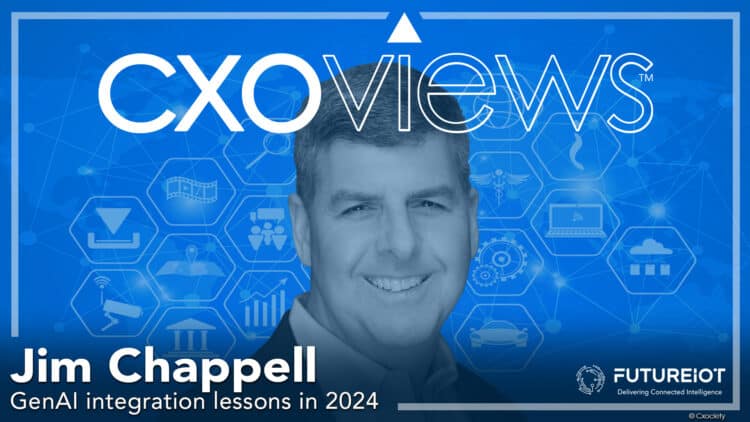IDC’s 2023 Future Enterprise Resiliency and Spending (FERS) Survey, Wave 6, highlights that almost half (43%) of organisations surveyed are currently exploring potential GenAI use cases. FutureCIO and FutureIoT leaders suggest that the trend will not fade anytime soon.
"Generative AI can increase the overall productivity of ITOps teams by streamlining ITOps workflows, lowering operational expenses, and increasing system dependability," says Dhiraj Badgujar, senior research manager for digital innovation practice and xOps program, IDC Asia/Pacific.
He cautions that any GenAI success will only come if properly implemented to ensure that they correspond with enterprise goals and that adequate guardrails are in place to manage unanticipated events. The advice is not limited to the IT department.
FutureIoT spoke to Jim Chappell, global head of AI and advanced analytics at AVEVA, for his view on how organisations can better realise the gains of GenAI.
What does real generative AI (GenAI) adoption look like in enterprises in Asia?
Jim Chappell: The Asia Pacific region is at a crucial juncture in embracing Generative AI. Singapore is emerging as one of the most rapid adopters in the area, with 53% of executives currently experimenting with Generative AI.
As Generative AI is anticipated to enhance productivity and operational resilience across various functions, we can anticipate a growing number of organisations in the region to emulate the early pioneers, integrating the power of artificial intelligence (AI) into their transformation endeavours to drive business outcomes.
What are the early mistakes enterprises make while adopting GenAI?
One prevalent error that enterprises often commit is hastily joining the Generative AI trend without a strategic plan. As with all technologies, organisations should first assess where its implementation can yield the most significant impact. They can also start with smaller projects before scaling them across the entire enterprise.
Organisations should not adopt Generative AI merely for the sake of it; they should first identify a real-world business need and then address it using Generative AI, if applicable.
What technologies/tools in the workplace will GenAI replace?

Jim Chappell: With the ongoing advancements in large language models, Generative AI continues to offer more and more sophisticated capabilities. In the industrial setting, Generative AI is set to revolutionise mundane tasks, embraced by 67% of enterprises in their AI strategy.
With AI transitioning to technology leadership, recent projections envision a 60% surge in workers adopting personal AI tools, driving a BYOAI trend. Advanced machine learning and robotics will optimise processes, boost efficiency, and manage repetitive tasks, empowering human workers to concentrate on intricate problem-solving, decision-making, and creative endeavours.
To maximise the benefit of GenAI, what new skills should employees take on?
Jim Chappell: Employees should first acquire a fundamental understanding of what AI is, including areas of machine learning and predictive analytics. This involves skills such as interpreting AI-driven insights, adapting to predictive asset optimisation tools, and mastering grey-box modelling. A crucial part of this evolution includes expertise in data management, cybersecurity, and seamless AI integration into existing workflows.
Leveraging that foundation, they should then learn what differentiates Generative AI and what it can provide in a business context. Likewise, employees should understand what Generative AI does not provide, to manage real-world expectations and leverage the technology for maximum real-world value such as data contextualisation and problem-solving.
What will be future themes across GenAI in 2024/2025?
Jim Chappell: The convergence of profitability and environmental sustainability is accelerating as Generative AI becomes a driving force in addressing the climate crisis. Industries are increasingly adopting AI technologies to transition to greener operations.
Various types of AI, including Generative AI applications, predictive analytics, asset optimisation, and grey-box modelling, are aiding companies in achieving net-zero targets and reducing environmental impact. The marriage of sustainability and profitability is now a tangible reality, with AI optimising processes and fostering eco-friendly practices.
What is your advice for leaders managing the integration of GenAI in the enterprise?
Jim Chappell: To guarantee the successful realisation of Generative AI benefits within organisations, business leaders must shift their focus beyond the technology itself. Instead, they should undertake a transformation of how employees work, collaborate, address challenges, and contribute value.
Emphasising a people-centric approach becomes paramount, involving substantial initiatives to upskill and reskill employees and ensuring their ethical and responsible deployment of the tools. Cultivating a culture of experimentation is also valuable, commencing with smaller projects in areas conducive to Generative AI adoption.
Overall, real-world goals and business value should be emphasised over the technology itself. Generative AI can provide amazing assistance when humans have a clear vision of what they want to ultimately achieve.



